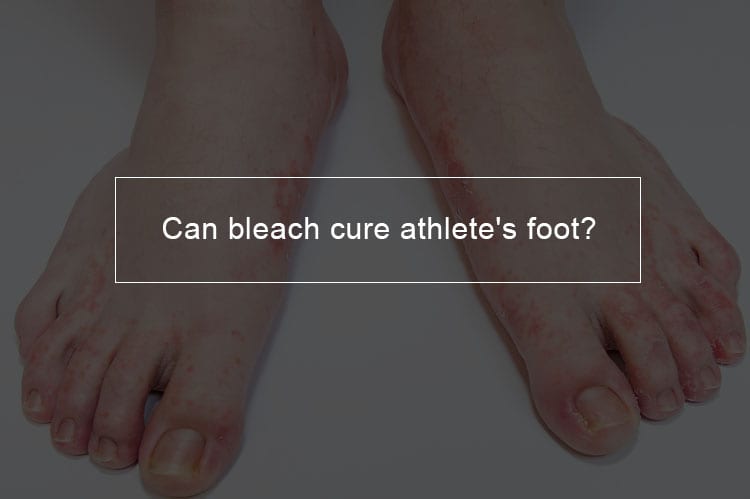
There are many over the counter treatments which are used to treat athlete’s foot fungus. Home remedies have also been invented to treat the infection. But does bleach kill athlete’s foot fungus? Read on to find out if it is safe to use bleach on your athlete’s foot.
Does bleach kill fungus infection?
What does soaking your feet in bleach do?
Athlete’s foot fungus can be challenging to treat, especially if it invades the toenail. Products such as bleach can kill the fungus, but one needs to be patient and apply the bleach for several days before the infection goes away. There are two ways to use bleach to treat athlete’s foot- as a soak and in a paste form.
However, bleach commonly known as sodium hypochlorite is a caustic substance which can irritate the skin, eyes and mucous membranes. It is therefore essential to always dilute the bleach with water before using it on your feet. Also, keep the chemicals away from your eyes and mucous membranes. And if the fungus does not go away or show signs of fading away in a few weeks, consult a podiatrist or a foot nurse.
Bleach soak for the feet
To prepare a bleach foot soak to follow the following steps:
Step 1: Get a tub or a bowl which is large enough to accommodate at least one of your feet.
Step 2: Fill the bowl with warm water and add about a cap of full bleach into the tub- the precise ratio you ill want is one tablespoon of bleach for one gallon of water.
Step 3: To make the fungus more accessible, even those on your toenail, trim the nails and file them.
Step 4: Soak your feet for about thirty minutes in the mixture. Do not go beyond this time as even with the dilution you risk burning your skin.
Step 5: Dry your feet thoroughly. Your towel might get discolored after drying. You will also notice the foot or leg hair color change due to exposure to the bleach.
Caution: Do not shave off your hair until you finish soaking to minimize discomfort. Repeat the procedure daily for at least two sessions in a day depending on how your skin reacts to bleach. This remedy takes longer to heal athlete’s foot compared to other home remedies; to clear the infection, it could take more than two months. You can also mix bleach with other ingredients to make it more effective. You might consider combining bleach with:
- Epsom salt
- Tea tree oil
- Oil of oregano
- Other natural oils that fight fungus
Bleach solution paste for athlete’s foot treatment
Some people recommend applying petroleum jelly to the infection and adding one to two drops of undiluted bleach to the petroleum jelly. The individual should then allow the bleach to rest for around fifteen minutes then rinse it off in the shower. One should then wear cotton socks before going to bed. A bleach paste is a more vigorous treatment than the foot soak. The foot soak may take time to see results.
How much bleach is needed to cure athlete’s foot?
Not much bleach is required to kill athlete’s foot. However, you should not keep adding more bleach to either of the two treatments because you feel they are not working fast enough. This will damage your skin and nails. You should also not use bleach sore skin or open wounds.
What are the side effects of soaking athlete’s foot in bleach?
Nevertheless, not everybody agrees with the use of bleach to treat athlete’s foot- some sites have considered bleach on athlete’s foot as unsafe. As discussed above sodium hypochlorite causes irritation, burns, and blisters to the skin. As such you should take precautions when using bleach to reduce the risk of hurting yourself. Getting rid of the athlete’s foot is high on the priority list, but individual health is more important. Follow the following practices to reduce the risk:
- Test to see if bleach is right for you. You can start with one to ten dilution of bleach and water.
- If your skin is not irritated, gradually increase the bleach to water ratio. And if your skin is irritated do not this method to treat the infection, instead see a doctor.
- Do not put bleach directly on the infection if you have sensitive skin. If applying the bleach directly to the nail is irritating, try soaking and remember to test on your skin first.
- Always remember that if bleach is not working there other effective remedies.
Can you use bleach pen to cure athlete’s foot?
Bleach pens are common for removing stains from fabric faster. Fortunately, you can use them on athlete’s foot and fungal nail just effectively. It will not only help to remove the discoloration but also it will kill the fungus causing athlete’s foot.
There have been many articles that suggest using bleach pen - along with bleach foot soak- can clear athlete’s foot faster. You may decide to use any of the two but combining the two will speed up the healing process.
To use a bleach pen on athlete’s foot, remove the cap and apply it directly to the infection and surrounding skin. The best part is bleach pens are easily accessible and relatively cheap. You do not have to dilute a bleach pen for toenail fungus since they mostly have a lower concentration of sodium hypochlorite. Bleach pens also have several ingredients which are not present in liquid bleach. However, if you experience any irritation, stop[ using the pen bleach to treat athlete’s foot immediately.
Will bleach foot soak discolor my toenails and feet?
You have probably used bleach to whiten out stains on your clothes. It will possibly do the same to your toenails and heels. However, this good is convenient if you have a toenail fungus infection. One of the common symptoms of toenail infection is discoloration where the toenail becomes yellow.
If you use a bleach soak or paste to treat fungus, one of the benefits is nails turning whiter and normal in color. However, on reasonable conditions, you should not use bleach to whiten your nails since it has too many threats. Remember bleach is a corrosive solution which could harm your skin if it is not diluted, thus using it to whiten nails or for cosmetic purposes is not a good idea.
How fast does bleach for athlete’s foot work?
The appeal of bleach is that it is a strong solution. It is therefore reasonable for individuals to think it will work faster, but this is not true. Bleach has to be heavily diluted for it to treat athlete’s foot.
The athlete’s foot will not go away overnight. But you also have to remember that it did not develop overnight. The best thing you can do is to start treating athlete’s foot early, just as it starts to develop and also stop the activity which is causing it such as wearing tight shoes and wet socks. You should also not stop the treatment just because the infection looks like it is fading away. Whether you are using bleach or any other treatment, keep using it for a few weeks after the fungus has cleared up to ensure it has gone completely. Always remember that not all treatments work on everyone; some skin reacts differently to products.
How do you kill athlete’s foot?
How to cure athlete’s foot?
As you battle with athlete’s foot, know you can fight back the infection with home remedies and over the counter-interventions. , however, is if you have diabetes or circulation problem you should see a doctor. Below are natural ways to treat athlete’s foot.
Soak your foot in vinegar
To treat athlete’s foot, soak your feet in equal portions of vinegar- you can use white or apple cider- and water for fifteen minutes at least twice in a day. Dry your feet thoroughly after each soak and moisturize with petroleum jelly.
Vinegar socks wash to kill athlete’s foot
Put in a cup of white vinegar to your wash loads and soak your socks for about ten minutes. Wash them thoroughly to kill any fungus present in the socks.
Air your shoes out to prevent and cure athlete’s foot
Let your shoes air out in the sun to kill any fungus that is inside them. It is best to intersperse shoes so that you can give them enough time to air out.
Soaking feet in bleach and vinegar
Bleach and vinegar are both active fungal infections killing agents when used individually. Even though bleach is a strong disinfectant, and vinegar kills fungi and bacteria. Mixing bleach with an acid such as Apple Cider Vinegar creates chlorine gas, which a toxic chemical which can be deadly at high levels.
Chlorine gas fumes can cause eye and skin irritation even in low amounts. They can also cause respiratory infections such as nose and throat irritation, coughing, difficulty in breathing as well as headache and dizziness if such a case happens to provide good ventilation and call a doctor.
Bleach is also harmful when combined with other chemicals such as ammonia and hydrogen peroxide. Instead, bleach is safer when diluted with cold or warm water. For a proper athlete’s foot treatment using bleach mix it with gallon water and proceed to treat as directed in section one.
How to prevent athlete’s foot?
In spite of the name, athlete's foot can happen to anybody. It is a frequent fungal infection that most people get from walking barefoot in moist, public places like a swimming pool deck or locker room. To minimize the chance of catching athlete's foot, dermatologists recommend that you take the following precautions:
- Even if you are not barefoot in public areas, make sure your feet dry. This fungus does well in warm, moist regions such as the one built inside hot, sweaty shoes. Putting on sandals or flip-flops helps to reduce an athlete's foot occurrence when it's hot outside. Shoes that have synthetic materials like plastic and rubber are more likely to cause sweating.
- Put on socks made of natural fabrics or wick moisture away from the skin. Also, ensure you change your socks every day and more often when your socks get wet.
- Wash your hands after touching your infected feet to avoid spreading the infection to other parts of your body.
- Sterilize any area that your bare feet come in contact with to avoid infecting others and re-infecting yourself.
- To reduce sweating during the day, always keep your feet dry and wear cotton socks.
- Put on shower shoes or sandals when walking around pools, gyms, shower or locker areas, and hotel rooms. The fungus that results in athlete's foot may be on the ground. It is essential to wear shower shoes or flip flops even when showering in a gym.
- If you live with someone who has been infected by athlete's foot, don't share towels, linens, or shoes. When visiting places, the affected have been wear shoes.
- If your athlete's foot is not healing or is worsening, you should make an appointment to see a board-certified dermatologist.




